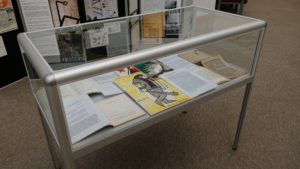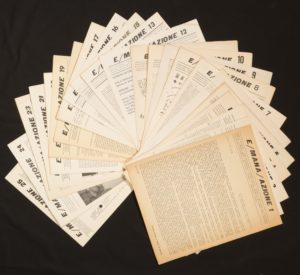First-time exhibition organiser
It was extremely rewarding to find and bring together fascinating material, but there was a lot to learn along the way. This first blog post looks at the practicalities of setting up an online and physical exhibition.
Deciding what to include
At the study day on ‘1968 in reviews’ in May 2018, speakers presented an amazing range of literary and cultural reviews, some of which were held in small archives, or were ephemeral publications that had not been studied before. The material was strikingly visual in lots of cases, so seemed ideal for an exhibition whose visitors might not read the languages concerned.
Mererid Puw Davies showed pages from amBEATion and other underground reviews, and was kind enough to lend precious copies for display at the European Research Institute, University of Birmingham.

Emanuela Patti showed us reviews from the Archivio Luciano Caruso in Florence, then acted as interpreter when I spoke to its director, Sonia Pucetti-Caruso, who send beautiful photographs of material from the collection.

Andy Stafford introduced us to the Moroccan journal Souffles as well as anthologies of its articles in French and in English translation, and also put me in touch with editor Abdellatif Laâbi, who generously gave permission to display the texts to appear shortly on this site.

Practicalities
Mounting the exhibition involved not only research and writing, but also identifying venues, populating the website, hiring display boards and a case, arranging for journals to be photographed and securing permissions to do so.
Working together
A colleague advised me not to organise an exhibition on my own, which proved to be excellent advice. I was very fortunate to work with Niven Whatley, who researched and wrote the contextual information, recommended the brilliant web designer, and found photographs to improve the display.
Many other people contributed to making the exhibition work, from Ellen Pilsworth, who first identified and translated reviews in German such as Kommune I, to Ray at Streamline Imaging, who printed the photographs.
By striking coincidence, the organisers of the Graduate Centre for Europe at the University of Birmingham chose ‘Protest and Activism’ as their theme for 2019-20, so we collaborated to put on a discussion of print culture and protest surrounding the exhibition on 16 October 2019.
If asked to give advice on putting together an exhibition, I would say the following:
Start early: libraries can take up to a year to process requests, and venues often plan ahead further than that, especially if your event is to be associated with an anniversary.
Remember to factor into the budget fees to have images produced, and to pay the image holder (e.g. a library) and the image creator (e.g. an editor, writer or artist) for permission to use them. Do ask if fees can be reduced or waived for a non-profit-making educational project.
Enjoy it! It’s fantastic to share material you have discovered with interested people, and to learn from experts who are enthusiastic about their knowledge and generous with ideas and advice.
